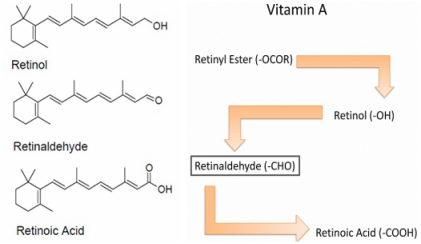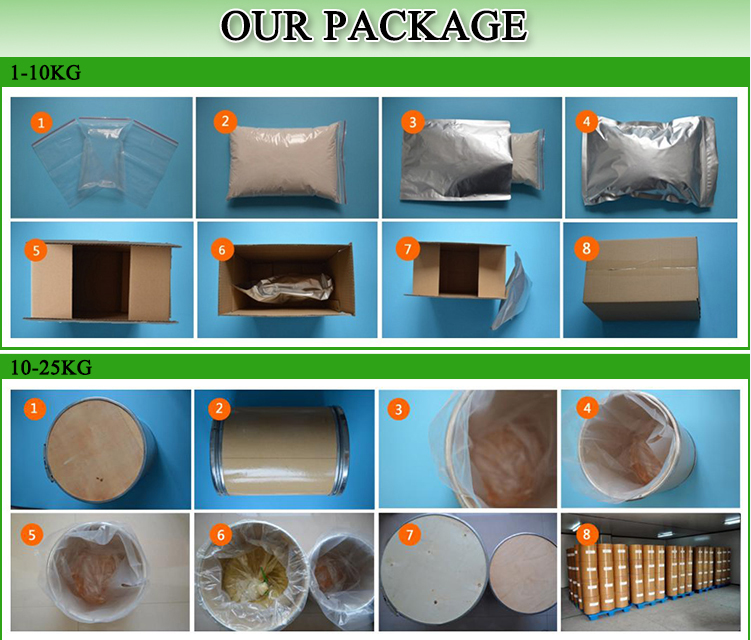1. Retinol Overview
Retinoids, also named vitamin A derivatives generally refer to compounds with the main basic structure of vitamin A and its oxidative metabolites. In recent years, a large number of studies have shown that the retinoids have significant effects in anti-aging, anti-acne, whitening, and anti-oxidation. Retinoids mainly include retinol, retinal and tretinoin (tretinoin).
There are multiple chiral isomers of retinoic acid; the most common is all-trans retinoic acid. Retinol is also known as vitamin A1. After dehydrogenation, it becomes retinol, called vitamin A2, and its activity is 40% of vitamin A1.

When retinol is used topically, it converts to retinoic acid by specialized enzymes found in skin, and interacts with intracellular protein receptors, then playing its anti-aging role. Additionally, retinol can promote the production of fibroblasts, and reduce the degradation of collagen. It increases and improves the amount and structure of collagen in the skin. Retinol is widely used in the prevention and treatment of skin aging and photo-aging. Also, retinol has the skin-whitening and anti-acne properties.
Retinal, also named Retinaldehyde, is an intermediate metabolite of retinoic acid. It has similar biological activity as retinoic acid, and its tolerance to skin is significantly better than that of retinoic acid. Retinal has many targets in the skin. It can produce good skin rejuvenation, and anti-acne effects when used in skin care products. It is an emerging high-efficiency natural active ingredient.
Tretinoin, also known as retinoic acid, is the first retinoid compound approved by the US Food and Drug Administration for topical treatment of acne. Because of its strong penetrating potency, tretinoin is also very effective on the skin. Tests have shown that tretinoin can accelerate the peeling of blackheads, and improve hyperkeratosis. At the same time, it can inhibit inflammation and reduce oil secretion. Therefore, tretinoin has a good effect on acne. It mainly plays a anti-acne role in cosmetics.
| Product Name | CAS Number | INCI Name |
| Retinol | 68-26-8 | RETINOL |
| Retinal | 116-31-4 | RETINAL |
| Tretinoin | 302-79-4 | RETINOIC ACID |
| Molecular Weight | Molecular Formula | Molecular Structure |
| 286.45g/mol | C20H30O |  |
| 284.44g/mol | C20H28O |  |
| 300.44g/mol | C20H28O2 |  |
2. Retinol Manufacturer Specifications
| Items | Specification |
| Purity | ≥95% |
| Assay | ≥45% |
| Appearance | Pale yellow to reddish brown liquid |
| Physical Characteristics | |
| BHT | 3.15%-3.50% |
| BHA | 0.90%-1.10% |
| Heavy Metals | |
| Heavy metals | ≤10ppm |
| Pb | ≤2ppm |
| As | ≤2ppm |
| Hg | ≤0.1ppm |
| Cr | ≤2ppm |
| Microbiological Tests | |
| Total Plate count | ≤1000cfu/g |
| Yeast & mold | ≤100cfu/g |
| Escherichia coli | Negative |
| Staphylococcus | Negative |
| Salmonella | Negative |
3. Retinol, Retinal and Tretinoin Benefits
- Retinol Benefits for Skin
Retinol as a messenger can promote the proliferation of keratinocytes in the basal layer of the epidermis. It can stimulate the synthesis of type I and type II procollagen on fibroblasts. Let the skin be filled with collagen again, filling the areas where wrinkles and sagging have appeared.
Moreover, The cause of skin photo-aging is that matrix metalloproteinase (MMP), which is over-activated by ultraviolet rays, is overactive and destroys the still-functional collagen. Retinol can suppress the activity of MMP1 and MMP9, which are excessively excited by ultraviolet rays, then reducing the damage to collagen fibers, and preventing photo-aging. Thus retinol prevents the appearance of wrinkles and sagging skin.

Figure. 0.1% retinol in treatment of fine lines at baseline, 6 months and 9 months
Retinol can inhibit the expression of tyrosinase and tyrosinase-related proteins in murine B16 melanoma cells, thereby inhibiting melanin synthesis. Topical application of retinol can regulate and control the function of melanocytes, reduce melanocyte activity and prevent melanin from being transported to the skin surface. Retinol is very effective in skin whitening and brightening.
- Retinal Benefits for Skin
Retinal directly interacts with protein receptors in cells to stimulate the skin epidermis to accelerate renewal. It increases the thickness of the stratum corneum, and makes the skin firmer. At the same time, retinal can accelerate the production of collagen in the dermis, prevent UV from destroying collagen, and inhibit the increase of MMP caused by UV. Retinal’s unique aldehyde structure is strong against propionibacterium acnes, etc.
- Tretinoin Benefits for Skin
Tretinoin mainly inhibits the expression of TLR, prevents the production of interleukins and interferons. In addition, tretinoin can eliminate sebaceous gland blockage, and reduce the number of Propionibacterium acnes flora.
4. Retinol Pharmacological Studies
Pharmacological Studies of Retinol and Cosmetics
| Test Item | Concentration | Result |
| Promotes the proliferation of epidermal keratinocytes | 10μg/mL | Promotion rate: 169.2 (blank 100) |
| Promotion of collagen production by fibroblast culture | 0.01% | Promotion rate: 129.5 (blank 100) |
| Improvement of skin wrinkle depth reduction by coating | 0.01% | Improvement rate: 67.9% (Compare with control group) |
Pharmacological Studies of Tretinoin and Cosmetics
| Test Item | Concentration | Result |
| Promotion of collagen Ⅰproduction by cell culture | 5μg/mL | Promotion rate: 180 (blank 100) |
| Promotion of collagen Ⅲ production by fibroblast culture | 0.1×10-6 | Promotion rate: 104 (blank 100) |
| Promotion of elastin production by cell culture | 0.5μmol/L | Promotion rate: 140 (blank 100) |
| Proliferation of epidermal keratinocytes promoted by cell culture | 5μmol/L | Promotion rate: 215 (blank 100) |
| Promotion of hyaluronic acid production by cell culture | 0.03% | Promotion rate: 198.5 (blank 100) |
| Protection against skin damage from ultraviolet A exposure | 0.03% | Protection rate: 82% |
5. Retinol VS Retinal VS Tretinoin
- Bioavailability: tretinoin>retinal>retinol
Retinal’s is more bioavailable; it can be absorbed more quickly and more fully by skin. Clinical study has proven that retinal works out 11 times quicker than retinol.
- Irritation: retinol>retinal>tretinoin
Retinol is most mild to the skin among the three. It’s more tolerant to skin; and retinol is more gentler to skin than retinoic acid.
- Efficacy: tretinoin>retinal>retinol
Retinol and retinal will work when they are converted into retinoic acid. Retinol firstly need converting to retinal and then to retinoic acid, which means that retinal only has one conversion to retinoic acid. More importantly, the last step is highly fast compared to the former conversions which is why retinal is more effective than retinol.
- Popularity in cosmetic formula: retinol>retinal>tretinoin
Retinol is most popular cosmetic ingredient among the three, because of its low irritation and significant effect for anti-aging. Retinal is a gradually arising raw material for cosmetic. Retinoic acid is commonly used for prescription.

6. Retinol Reference Dosage
Retinol, retinal and tretinoin are widely used in anti-aging and anti-acne skincare products, including facial mask, emulsion, essence, face cream, sunscreen, and other types of cosmetics.
The European Scientific Committee on Consumer Safety (SCCS) estimates that the skin absorption rate of retinol is about 5.7%. Norway stipulates that the maximum concentration of retinol in cosmetics is 0.3%. In the cosmetics formulation, the commonly used concentrations of retinol are: shower gel: 0.01%-0.05%, face cream and hand cream: 0.01%-0.3%. The limit concentration is 0.3% retinol for shower gel and 1% retinol for face cream and hand cream.
Tretinoin’s recommended dosage in anti-acne cosmetics is 0.01% to 0.4%. More specifically, in gel dosage is 0.01% to 0.25%; in cream dosage is 0.025% to 0.1%; in lotion and emulsion dosage is 0.05%.
| Product | Reference Dosage |
| Retinol | ≤1.0% |
| Retinal | ≤2.0% |
| Tretinoin | 0.025%-0.4% |
7. Retinol Uses
Retinol Uses in Cosmetic Formula
- Retinol can be used with nicotinamide in cosmetic formulation to better exert anti-aging and skin-whitening effect.
- Retinol can be formulated with sodium ascorbyl phosphate (SAP) for treatment of acne and pimple.
- In order to reduce the drying effect of retinolon skin, the cosmetic formula can be combined with moisturizing active substances, such as nicotinamide, ceramide, hyaluronic acid, etc.
- It is recommended to add antioxidant BHT, vitamin E and other ingredients in the oil phase, and add antioxidant vitamin C or its derivatives to the water phase to improve the stability of the retinol
- The solubility of retinol in mineral oil is 2.5mol/L, so refined mineral oil can be used as one of the main oil components of the formula.
- The optimal storage temperature is below 4℃and avoid light.
8. Reference Cosmetic Formula
Skincare Cream
| Ingredient | Content(%) | Ingredient | Content(%) |
| Retinol | 0.5 | Cetyl Alcohol | 0.5 |
| Cetyl Lactate | 10.0 | Rutin | 3.0 |
| Mulberrin | 3.0 | Silymarin | 2.0 |
| Glycerin | 2.0 | Tween 60 | 0.25 |
| Deionized Water | Add to 100 | ||
Anti-aging Cream
| Ingredient | Content(%) | Ingredient | Content(%) |
| Retinal | 0.1 | Peptide Oleamide | 0.1 |
| Tocopherol | 0.5 | Glycerin | 6.0 |
| Edta | 0.1 | Phenoxyethanol | 0.35 |
| Cetanol | 1.0 | Caprylic / Capric Triglyceride | 10.0 |
| Dimethicone | 4.0 | Dicaprylyl Carbonate | 4.0 |
| Deionized Water | Add to 100 | ||
9. Retinol, Retinal & Tretinoin Safety
- Cosmetic, Toiletry &Fragrance Association (CTFA) has specified RETINOL, RETINAL and RETINOIC ACID as cosmetics ingredients.
- RETINOL, RETINAL and RETINOIC ACIDare included in The International Catalogue of Chinese Cosmetic Raw Materials Standards in 2010 issued by CAFFCI.
- RETINOL and RETINAL are listed On the Announcement of Name List of Cosmetics Raw Materialpublished by CFDA in 2021. No reports show its insecurity.
- RETINOIC ACIDis prohibited to use in cosmetics in China.
10. Packing and Storage
Package: Packed in 1kg aluminum foil bag, or 25kg paper drums with two plastic bags inside.
Storage: Stored in a cool dry place and away from direct sunlight and oxidizing agents.

11. Related Reading
Plamed focuses on natural cosmetic ingredients for more than 10 years. We have founded four subsidiary companies, which respectively develops different kinds of cosmetic raw material. Plamed is a company whose CEO is designated as the first secretary general of Shaanxi Plant Extraction Association.
As a professional retinol manufacturer, Plamed have been constantly upgrading the production process. We firmly believe that good retinol and good retinol price will help customers make good terminal products and help customers win a lasting and broad market.













